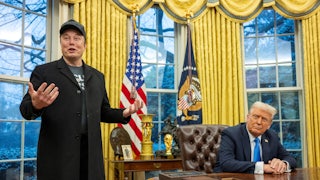In American politics, a presidential campaign cannot coordinate with its associated political action committee. The campaign can wink and nod publicly in the press and on its official website, but a direct line of communication is, technically, illegal. In much the same way, Donald Trump cannot coordinate with Russia. He cannot call up Vladimir Putin (as he once famously called up Volodymyr Zelenskiy) and ask for help swinging the election. Still, when it comes to winking and nodding, everyone is on safe, legal ground.
It was ostensibly legal, for example, when Donald Trump encouraged the Russians to find Hillary’s emails in 2016; or when, in 2018, he sided with Putin over the U.S. intelligence agencies. And it’s ostensibly legal for Trump to help Putin when he can—as in his recent order to Republican congressmen to block aid to Ukraine. But the legality of Trump’s behavior doesn’t make it any less galling when the former president says things like he would “encourage [Russia] to do whatever the hell they want” to any NATO countries that don’t pull their financial weight.
These were astounding remarks—a break with a Republican dogma established by Ronald Reagan, who called NATO “the core of America’s foreign policy and of America’s own security.” And yet, these winks and nods at Putin are not a new feature of Trumpism. Then-candidate Donald Trump made an eerily similar remark in July 2016, telling The New York Times that he would tell NATO states who haven’t paid their dues, “Congratulations, you will be defending yourself.” Trump has viewed NATO as a protection racket for as long as he’s been a politician. He’s admired Putin for even longer.
Perhaps these are old features of Donald Trump, predating his political movement. The notable difference is how the Republican Party has come around to Trump’s views. Lindsey Graham said Trump’s 2016 anti-NATO remarks “make the world more dangerous and the United States less safe.” After Trump expressed the same sentiment in 2024, Graham said, “President Trump is right to want NATO nations to meet their obligation.” There is a hell of a lot of light between those two responses.
Naturally, when it comes to flip-flopping your way into Trumpism, Graham is perhaps the gold standard. But this pro-Putin shift is palpably evident among many of Graham’s Republican colleagues. It’s been a decade-long unraveling. During the Obama years, Vladimir Putin was frequently cast as a foil to the American president—with conservatives aghast at what they saw as a toughness gap. After Putin annexed Crimea in 2014, Sarah Palin said on Fox News, “People are looking at Putin as one who wrestles bears and drills for oil. They look at our president as one who wears mom jeans and equivocates and bloviates.” Sean Hannity used the occasion of Obama being photographed wearing a bicycle helmet to mine this same vein, declaring, “Putin: big, strong, muscular on a horse. There’s Obama riding a little bicycle with a helmet on.”
But the trope of of Putin as the anti-Obama began with Trump. By the time Palin and Hannity made the aforementioned remarks, Trump had already said that Vladimir Putin “has no respect for Obama,” that “Putin is laughing at Obama,” that “Putin is much smarter than Obama,” and that “Putin is having such a good time. [Obama] is making him look like the genius of geniuses.”
As with all things in the Obama-to-Trump whiplash, there’s a strong cultural vein to the shift that slowly began to ensue—where Putin went from being the sort of figure that the resident of the White House needed to be capable of pushing around to a figure of admiration in his own right, eventually leading to something akin to a right-wing fandom. After Russia passed a monumental (and widely condemned) anti-gay law in 2013, one Daily Caller editorialist praised the country for “resisting the political movement to regularize and even celebrate [homosexuality],” adding that many Russians “are appalled, as are many Americans, at how these sexual practices and lifestyles are celebrated in the United States.” It’s worth noting that, at the time that column appeared, gay marriage was still illegal in the U.S.
While much of Vladimir Putin’s public image—the Übermensch who rides horses shirtless and baptizes himself in icy lakes—is a collage of Kremlin propaganda, it’s clear that Putin understands the wedges that divide America, and he has leaned into this role as an outside crusader in the ongoing American culture war. Professor Angela Trent, author of Putin’s World: Russia Against the West and With the Rest, says, “I think what Putin’s doing right now is watching very carefully … it was clear in his interview with Tucker Carlson that he was aware of a lot of these trends.”
Carlson’s tête-à-tête with Putin was an interesting acid test for how widespread the pro-Putin sentiment really is in America. After its broadcast, there was a clear understanding that Putin had effectively used Carlson for nothing more than spreading propaganda—Carlson made no news, and Putin was offered a friendly audience in the West. But very few Republican politicians were willing to publicly condemn Carlson for his transparent role in amplifying the Kremlin’s agenda. Nor have they shown much concern that their entire Biden impeachment probe might simply be another product spun up by the Kremlin.
Trent notes that Russia’s state-run television propagandists “are just wild about this. They just think Tucker Carlson’s wonderful, and you know, all of the people in the Republican Party who are saying nicer things about Putin than Biden and denigrating Ukraine. So they’re watching this.” Meanwhile, Carlson clearly understands that his softball interview with Putin and his praise of Russia’s autocratic system was a step too far—he’s been defending it ever since. But the damage has been done, as the former Fox host and his ilk have spent the past few years pushing the Overton window into a place where a pro-Putin stance is no longer unacceptable within the GOP.
Despite this campaign from figures like Carlson and Trump, not everyone in the Republican Party has completely abandoned their Reagan roots, as was evidenced by the actual policy coming out of the White House and Congress during Trump’s first term. Under Rex Tillerson and his successor, Mike Pompeo, the State Department took a strong position on countering Russian aggression, pulling out of the Intermediate-Range Nuclear Forces Treaty and sending Javelin missiles to Ukraine. Trump’s administration regularly issued sanctions against Russia during the first three years of his presidency. On the campaign trail, he called NATO “obsolete.” In the White House, he said the alliance was “no longer obsolete.” Much of that posturing and hard policy has to be attributed not to Trump’s swaying fancies but to the influence of the old-guard Republicans within the administration.
But those with fealty to the Reagan doctrine are likely to be purged from a second Trump administration, should any be fortunate enough to wriggle their way in now. Over the past months there have been a flurry of reports that Trump will staff a second administration with voices who, rather than moderate his authoritarian impulses, are likely to push him further into authoritarianism.
Stent notes, “In the Trump administration before, you did have a group of Republicans—and they were there before and they kind of became more pronounced—who kind of admire what Putin put forward as Russia as the harbinger of traditional family values.” Trump himself has also become more comfortable with his pro-Putin stance. In 2016 he furiously batted down the Steele Dossier and allegations that Russia was propping up his campaign. He has made no such denials on the 2024 trail, even as Nikki Haley made tying Trump and Russia together the main argument of her South Carolina strategy. For a while, it seemed as if Haley might have some appeal to voters who cast themselves in the Reagan Republican mold, but as the results on Super Tuesday demonstrated, these were too few and far between to sustain her campaign.
As typified by much of the intraparty split in recent years, the pro-Putin branch of Republicans are noticeably louder than the Reagan descendants. Emboldened by Trump’s rhetoric, Steve Bannon, Candace Owens, Laura Ingraham, and Marjorie Taylor-Greene have praised Putin’s “anti-woke” policies and defended his invasion of Ukraine. William Galston, an expert on political trends at the Brookings Institution, notes that “under the influence of Donald Trump, a lot of Republican rank-and-file voters are shifting on the issue of international engagement, alliances and aid to Ukraine.” But Galston also says, “I don’t think that Trump has made the sale yet to the rank-and-file about Putin’s genius. I don’t see any survey evidence that a majority, or anything like it, of the rank-and-file shares Trump’s views on that subject.”
The polling supports the idea that most Americans—even Republicans—have a dim view of Putin and Russia. But of course Putin cares more about taking Ukraine than about Americans’ opinions of him. According to Pew Research Associate Moira Fagan, the data shows that “starting in 2015, the partisan gap widened: Democrats became more likely than Republicans to express a negative view of Putin.” She adds that, though Republican confidence in NATO increased after Putin’s invasion of Ukraine, it has since dropped from 55 percent to 49 percent.
Vladimir Putin has made it clear that he does not intend to end his war in Ukraine—a war that the Ukranians will almost certainly lose without American dollars. He told Carlson the war would be over “within a few weeks” if America stops supplying weapons. And though the Senate approved a Ukrainian aid package, it has been languishing since Donald Trump issued marching orders to his underlings in the House. The argument, of course, is that Republican congressmen fear invoking the ire of Donald Trump—and the prospect of losing their jobs as a result. But the reality—at least according to the polling—is that Ukraine aid is unlikely to sway many votes in 2024.
This is a reality of larger issues. By normal standards, Trump’s abandonment of the Reagan doctrine and appeasement of Putin is a huge deal. But this is an abnormal election cycle. The overturning of Roe v. Wade has had a seismic effect on the map. Like it or not, Joe Biden’s age is a glaring issue. Immigration, inflation, and crime are all still atop voters’ minds. And Donald Trump’s weakness is that, well, that he’s Donald Trump. Still, there is a chance that Ukraine, Russia, and Putin might become larger issues as November approaches. Galston notes that while international affairs aren’t presently a top priority for voters, “everything depends on how hard the two presidential candidates intend to push on this issue. The flow of debate in a general election can affect public perceptions of the salience of individual issues.”
Then again, this is Donald Trump. The man who could shoot a resurrected Ronald Reagan on Fifth Avenue and not lose a vote. One last bit of polling might be illustrative here: In 2018, after Trump endorsed Putin’s narrative of Russian meddling in the election over the American intelligence agencies’, multiple polls found that it had no impact on his approval rating. It’s another stunning (and yet largely ignored) factor of Trumpism—when it comes to Russia, his voters just don’t care.










